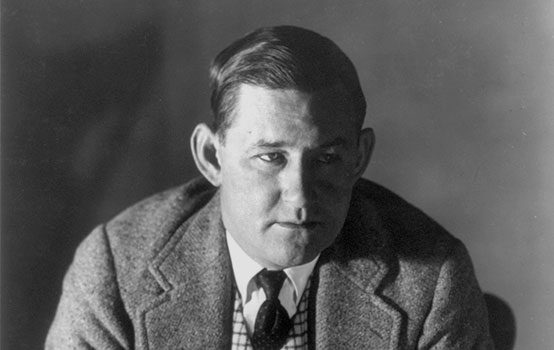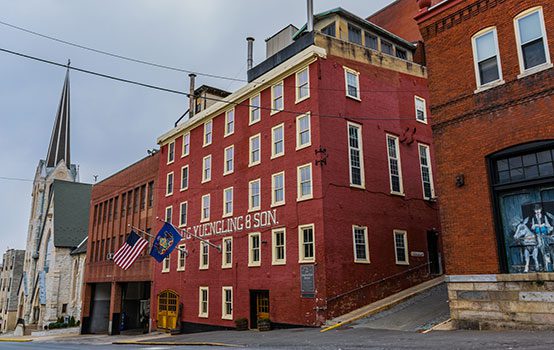It’s Time to Read John O’Hara Again

Writing in his memoir about the literary avant-garde of Paris and New York in the 1950s and 1960s, Richard Seaver lamented the imperfections of memory. The late publisher and editor cautioned that, “Time is not kind to the harried mind.” Seaver explained that he “tried to tell these tales as they were, accurately and fairly, and if I have erred or memory has betrayed, blame it on those Irish genes my wife has encountered over the years.”
It’s a safe assumption that the once prominent American writer John O’Hara would never issue such an apologia. Irish genes predispose their recipients to hyperbole and embellishment, but O’Hara wasn’t a carrier of this ancestral foible. His meticulous devotion to detail produced novels and short stories that captured the cultural temperament and consumer preferences of America between the 1880s and World War II. He didn’t want us to forget either, as his epitaph suggested: “Better than anyone else, he told the truth about his time. He was a professional. He wrote honestly and well.”
O’Hara died in 1970, but the imperfections of literary appreciation—accompanied by the unremitting passage of time—have sentenced the author’s work to a cruel purgatory of faded memory. The latest attempt to revive O’Hara’s legacy comes through the Library of America, which recently released a volume of sixty stories. The collection, compiled by the New York Times’ Charles McGrath, reminds us that O’Hara remains the Bard of the American Short Story.
Once known as the “master of the fancied slight,” O’Hara has suffered a posthumous assault for his grudges, arrogance, and alcohol-induced temper. His contemporaries in mid-20th century Manhattan acknowledged his talents but denied him absolution. And so O’Hara’s penance lingers with each passing decade, with no revival restoring his invaluable and boundless literary contributions.
As critics frantically search for historical and literary clarity during this newly christened Trump era, John O’Hara’s work is a necessary start. His stories provide a factual account of the period of unparalleled growth during the late 19th and early 20th centuries. At a time dominated by Snapchat, where people express without reflection, O’Hara offers a curative message into how people actually think, feel, and experience the extraordinary and ordinary of everyday life.
♦♦♦
Born in 1905, O’Hara’s anthropological sense of place wasn’t nurtured on the tension-soaked streets of some coastal Eastern metropolis. His brilliant gift for observation and ear for dialogue germinated instead in Pottsville, a small city tucked away in the anthracite coal region of Schuylkill County, Pennsylvania. It’s impossible to understand O’Hara without understanding his hometown.
Pottsville was the commercial center of the region’s southern coal field. Approaching O’Hara’s hometown on Route 61, one can recognize the important role this city once played during the height of the Industrial Revolution. Its grid of dramatic hills supports blocks of pre-World War II architecture, structures dressed up in the ornate styles that only Gilded Age wealth could build. Overlooking the city of steeples and Federalist townhomes is the Schuylkill County Courthouse, a massive Queen Anne edifice that conceals the region’s darkest chapter in history.
Located behind the courthouse is the county prison, a brownstone castle façade dating back to 1851. It was here, on June 21, 1877, that six men were executed for their alleged acts of violence against mine bosses. The men were believed to be members of the Molly Maguires, an oath-bound Irish secret society with agrarian roots in Ulster.
During the 1860s and ’70s, Irish laborers protested the medieval conditions of the mines and company towns. A series of heinous crimes were committed against Welsh and English mine bosses, and the acts were subsequently tied to these Irish laborers. The powerful Philadelphia & Reading Railroad, which controlled Schuylkill County’s mines and railroads, hired a Pinkerton detective to uncover the alleged Mollies’ crimes. Twenty Irishmen were placed on trial and they were convicted by mostly German-speaking juries. The hanging of six men in Schuylkill County was part of the largest mass execution in Pennsylvania history.
Historians continue to debate the very existence of the Molly Maguires. The historian Kevin Kenny wrote that the Mollies “have been depicted in every imaginable way, from sociopaths and terrorists at one end of the spectrum to innocent victims and proletarian revolutionaries at the other.” Regardless, any association with the Mollies or Ancient Order of Hibernians risked excommunication from the Roman Catholic Church. Archbishop James F. Wood, a convert from a patrician Philadelphia family, frightened the region’s Ulster and Connaught immigrants with this threat, and so the very mention of the Mollies remained verboten through the early 20th century.
The Mollies’ legacy still haunted the region during O’Hara’s youth, a time when he digested the stark and latent cultural complexities of his surroundings. A devout social historian, O’Hara recounted the ethno-religious tensions in his “Gibbsville” stories, the fictional name he pinned on his hometown in honor of The New Yorker’s Wolcott Gibbs. In just one example, “Afternoon Waltz,” O’Hara reports the unspoken strain between an Irish-Catholic maid and her Welsh-Methodist host family. In spite of the divisions that the Mollies created among the Irish, O’Hara wrote that the “non-Mollies were loosely united with the Mollies by the common enemy, the Welsh Protestants, and when Sarah Lundy first went to work for the Evans family neither party could guess how the arrangement would work out.”
♦♦♦
When not deciphering the socio-economic fault lines of his native geography, O’Hara revealed the endless flaws and disappointments of characters in Hollywood, Philadelphia, and New York. But when discounting O’Hara’s undervalued novels, his richest contribution remains the “Gibbsville” stories, a number of which can be found in the Library of America collection. Although the stories bracket a unique period of American society, O’Hara’s themes remain timeless through his evocative character portrayals. The stories grapple with money and class, with O’Hara exposing the resentment, perversion, insecurity, and cruelty of humanity as it reaches, retains, or loses its aspirations.
O’Hara’s stories were not clever literary inventions, but accurate depictions from his own memory and experience. He was raised in a “lace-curtain” Irish-Catholic family, growing up in a spacious rowhome—across from the Yuengling Brewery—on Pottsville’s fashionable Mahantongo Street. The O’Haras enjoyed a better place in the city’s social hierarchy than fellow members of their tribe, but their position remained tenuous. His father, Dr. Patrick O’Hara, was known as “the Irish doctor,” a founder of the city’s Catholic hospital, and a legendary surgeon for victims of mining accidents.

The Molly Maguire episode, bouts of labor unrest, and a growing Democratic Party induced a lingering anti-Catholicism and prejudice against the Irish. The Klan-fueled defeat of Al Smith in the 1928 presidential election only amplified this reminder. But the O’Haras enjoyed their place in society, and whatever subtle hostility existed was checked by their financial security.
As a boy, O’Hara enjoyed all the material possessions of a young country squire. If anything, O’Hara matured in a city where groups were segregated for their socio-economic standing. But a simple stroll along Centre Street exposed O’Hara to the WASP elite, Pennsylvania Dutch merchants, poor southern and eastern European immigrants, and the struggling working class members of his own tribe. It was through Pottsville that O’Hara learned how financial predestination determined not only where a person lived, but which college he attended and clubs he joined. The alternative was a life of factory jobs, too many children, and eternal economic insecurity.
As a young man, O’Hara was considered a snob, and a preference for riding boots didn’t help his reputation. But his social standing and material preferences didn’t discourage the boy O’Hara from playing with all children, regardless of background. O’Hara demonstrated this “spurious democracy” in his 1934 masterpiece, Appointment in Samarra.
The novel, set in Gibbsville in 1930, follows the downfall of Julian English over a three-day period during Christmas. O’Hara occasionally flashes back to Julian’s earlier years, such as when the sons of the wealthy and poor would play a ball game. O’Hara delineated what was left unsaid during ball games: “you did not talk about jail, because of Walt’s father; nor about drunken men, because there was a saloon-keeper’s son; nor about the Catholics, because the motorman’s son and one bookkeeper’s son were Catholic. Julian also was not allowed to mention the name of any doctor.”
O’Hara refined his craft when driving his father to house calls in the patch towns. While waiting in the car, he read F. Scott Fitzgerald, Sinclair Lewis, and Booth Tarkington. An early immersion in realistic character development, along with careful listening to how people spoke, inspired stories like the autobiographical “The Doctor’s Son.”
In life and fiction, O’Hara was paralyzed by his preoccupation with class. This yearning for recognition stemmed from a heavy dose of misfortune and self-destruction in early life. As a teenager, he floundered in prep school after prep school, until finally excelling and becoming valedictorian at Niagara University Prep. Approaching the academic finish line, O’Hara thought he might fill a slot at his beloved Yale. But a drunken night on graduation eve resulted in expulsion and shattered dreams. O’Hara’s misfortune continued with his father’s early death. Among Dr. O’Hara’s last words were, “poor John,” and a warning that his son had a spot on his lung. The father died without a will, leaving his family with almost no money.
After a faltering newspaper career, O’Hara’s misfortune slowly turned in New York, where he befriended members of a famed literary collective, the Algonquin Round Table. He is best remembered for his long and turbulent career with The New Yorker, which ran most of his short stories. But O’Hara’s fame never made him feel fully accepted into the club. O’Hara’s character flaws were indisputable, and yet his Irish Catholicism—no matter how hard he worked to drop it—was likely the biggest reason he only achieved partial membership in the Protestant-dominated establishment. When reporting for Time, O’Hara commented that his editor, Henry Luce, always gave him “that Protestant look.” He expressed this bitterness in his writing as well: “We’re Micks, we’re non-assimilable, we Micks.”
At a time when a large proportion of the population once again seems to feel alienated from the establishment, the characters of Gibbsville and beyond remind us that geographical and class divisions have long been part of the American story. And that is why it’s time to read O’Hara again.
Charles F. McElwee III works in the economic development sector in northeastern Pennsylvania.
Comments